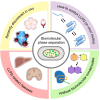Recent trends in studies of biomolecular phase separation
- PMID: 35880435
- PMCID: PMC9442351
- DOI: 10.5483/BMBRep.2022.55.8.101
Recent trends in studies of biomolecular phase separation
Abstract
Biomolecular phase separation has recently attracted broad interest, due to its role in the spatiotemporal compartmentalization of living cells. It governs the formation, regulation, and dissociation of biomolecular condensates, which play multiple roles in vivo, from activating specific biochemical reactions to organizing chromatin. Interestingly, biomolecular phase separation seems to be a mainly passive process, which can be explained by relatively simple physical principles and reproduced in vitro with a minimal set of components. This Mini review focuses on our current understanding of the fundamental principles of biomolecular phase separation and the recent progress in the research on this topic. [BMB Reports 2022; 55(8): 363-369].
Conflict of interest statement
The authors have no conflicting interests.
Figures



